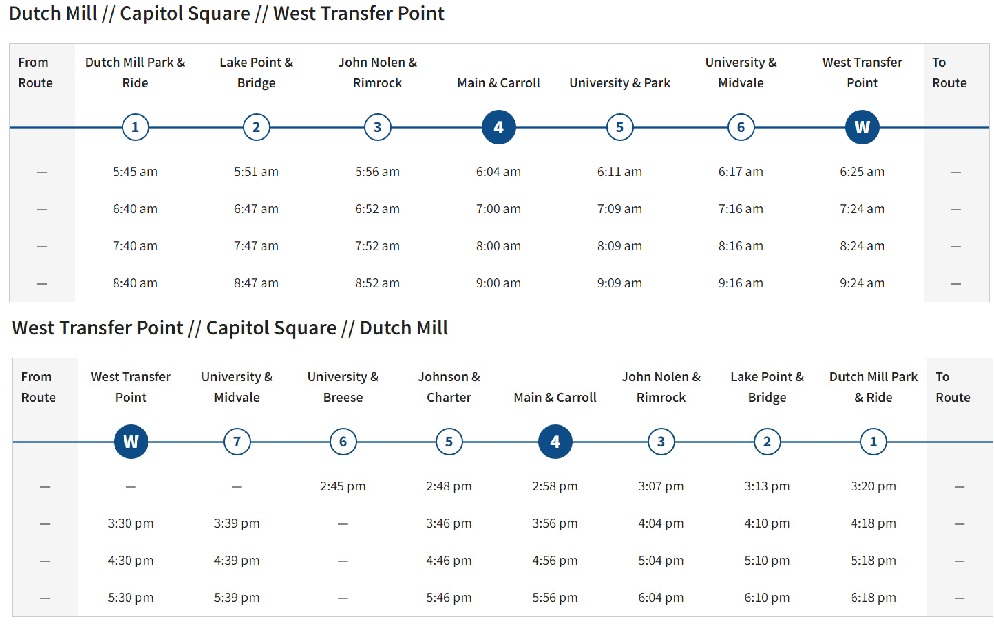A Pique About Peak
Susan De Vos | December 8, 2020


Although still only a fifth of what it was compared to a year earlier, Metro ridership in September and October 2020 has climbed back from its 10% level of March and April 2020. And thanks in large part to a grant of about $24.5 Million from the federal government's CARES Act, Metro began operating back at 85 percent of its previous year's level beginning at the end of August. Earlier, it had been running a much leaner Saturday-type service as people were minimizing potentially risky exposure to a new and often- lethal virus. Much of Metro's core routing was re-instated in late August 2020 but much of the more limited peak service to peripheral areas was not. Half the peak runs remained eliminated although they were often the only transit service available in the areas they served. Ironically, it is peripheral areas that house some of Madison's most low-income residents who can benefit most financially from not having to own and operate a car. Since peak-hour weekday runs tend to be the most expensive and logistically demanding, it makes sense that they would be targeted for elimination by cost-cutting measures. A peak route usually runs in only one direction, while the entirely or mostly empty vehicle must be driven back to storage in the reverse direction. Nor may a worker's time be used efficiently when a full-time worker operates a morning and then afternoon shift with idle time in between. Finally, the number of buses operating during peak hours is a major determinant of storage capacity requirements, an issue the former Metro General Manager Chuck Kamp felt primary, even more important than having an intercity bus terminal in Wisconsin's state capital. Metro's need for additional storage space is a story unto itself. Yet when land use planners would ask Metro how to include transit in their design of whole settlements or individual buildings on peripheral farmland or neighborhoods, they would be told that Metro would extend a limited peak hour weekday run to the area or building only, despite such runs being the most expensive option available and despite exacerbating the storage concern of their general manager. Why the dysfunction? Metro's planners knew the option the worst one financially but it was also the most favored option politically. Metro's attempts to budget in financing for increased frequency on such core routes as the #3 or #6 would get rejected repeatedly by the mayor and/or Common Council. But they could get funding to provide the more limited service. Might it be possible, if Metro proposed putting more of its resources toward providing better less-limited core service in lower income peripheral areas in the name of transportation equity that it would acquire the funding to do so? After all, the city's MetroForward announcement of 2019 listed as a reason to enact a $40 registration fee on resident automobiles that adopting MetroForward>> would "make transportation more equitable, helping families make ends meet." And in answer to its own rhetorical question of "HOW WILL WE GET THERE" the first of four items is "expand accessibility and service." (Implementing Bus Rapid Transit [BRT] is the fourth item listed after "Modernize Metro Facilities" and "Focus on Sustainability.") Would more widespread knowledge of transit's four to one multiplier effect make investing in our bus system more palatable politically? Would a better understanding of peak hour service's relative expense make it less palatable? The MetroForward brochure that came out in 2019 reports that "For every $1 invested in public transit, approximately $4 is generated in economic returns." (Nationally, the 2020 figure appears to be closer to five to one according to the American Public Transportation Association.) Unfortunately, the idea of proactive investment rather than reactive management is not politically favored in this environment, even when the multiplier effect is significant. What is politically favored unfortunately, is a shiny new project in which politicians can pose for pictures cutting ribbons. Thus despite the supposed rationale behind the big boost in Madison's car registration fee — that of expanding accessibility and service — there is a fear that the supposedly temporary cuts to service in peripheral areas imposed by the pandemic will stay even after the pandemic is over. Instead, parts of our current local system will be replaced by a shiny new Bus Rapid Transit (BRT) system despite BRT's 4th place on MetroForward's "How will we get there" list and despite BRT's starter route going through the center, not periphery, of Madison. That fear is partially assuaged by the fact that the city's Department of Transportation has engaged a knowledgeable consultant to perform a "network restructure" study that could propose radical re-routing and re-scheduling of Madison's public transit system, including any planned Bus Rapid Transit. At the same time, the regional Transportation Planning Board is engaged in a radical revision of the Madison Area's 5-year Transportation Development Plan, a revision that could well reinforce many of the same findings. Those findings will hopefully result in better attention to peripheral areas and to better local transit service than was the case even before pandemic times. In a thoughtful article that considered how the pandemic might alter the traditional peak travel pattern, Tiffany Chu talks about how "Covid-19 Is Not The ‘Death Of The City’ — It’s The Rise Of The Neighborhood Center." She argues that Transportation systems are often designed for peak commuters going downtown, which has plummeted since the pandemic. To not only recover but emerge improved, cities must invest in a travel pattern long neglected: the neighborhood trip. She talks about the 15-minute city where everything people need is within 15-minutes of travel by bike or foot from their home. She talks about how the pandemic caused transit ridership to shift to local routes connecting neighborhood centers, rather than downtown routes. Could that be our future as well? |